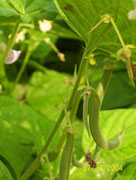


Home
Flowers &
Indoor Plants
Fruits & Nuts
Ornamentals
Vegetables
Special Topics
Resources
Glossary

Beans |
 |
What about it? Beans are members of the legume family, along with alfalfa, peas, and clover. There are many different kinds of beans: green snap, flat Italian, Lima shelling beans, and edible soybeans. Most garden beans grow on bushes (bush beans), although there are a few tall, vining types (pole beans). Beans are typically green, except for the yellow-colored wax beans. Some beans even have purple pods. What is it used for? Beans are legumes. Legumes are nitrogen fixers. This means that they create nitrogen, which is a vital nutrient in the plant world, and put it back into the soil. Nitrogen is important because plants cannot grow without it. Many people will plant legumes as a cover crop in the off-season or during a fallow year to recharge the nitrogen levels of their fields or plant beds. However, they are also eaten as a vegetable. Where does it grow? How do we grow it? Beans are sensitive to the frost and must be grown during the summer. They will take anywhere between 45 and 60 days to mature, depending on the variety. Stay out of the bean patch when the foliage is wet to avoid spreading any diseases. If you are growing pole beans you will need to set up a trellis or a tepee for support Sometimes it is a good idea to mulch snap and dried beans to keep the soil cool and retain moisture. What are its primary problems? Mexican bean beetles and Japanese beetles think that beans are just about the tastiest thing around. Aphids and leafhoppers will snack on beans if they get a chance. The seed corn maggots will attack sprouting seeds. Furthermore, beans are prone to these diseases as well: bacterial blight, snap bean rust, viruses, and white mold. Rotating the location of your bean patch from year to year will greatly decrease the likelihood of a disease outbreak. How do we propagate it? Beans are grown from seed. How do we harvest and store it? After the 60 days, the beans should produce a bountiful harvest. The beans should be slim and tender. If they appear bumpy you have waited too long, unless you plan to eat dried beans. The seeds inside may have become overgrown and will be tough to eat. Also, strings may develop near the pods that will greatly slow down or even stop plant production. Shell beans should be a bit more developed than the snap beans at picking time. When you pick the beans, be gentle. Be sure to take both the pod and the short stem. If the stem is removed the bean will lose moisture through the wound and will be more susceptible to disease. Beans will keep best at a temperature of 40 degrees F in a perforated plastic bag. These conditions will enable the pods to retain moisture and can be kept this way for about a week.
© Copyright, Department of Horticulture, Cornell University. |

